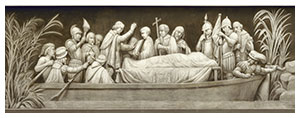 Today in 1541, the intrepid explorer Hernando de Soto, who followed Juan Ponce de León to have an outsized influence over Florida’s future, halted his caravan near what we call Walls, Miss., today to see, for the first time, the Mississippi River. For the Spaniard, Río de Espíritu Santo was, at worst, an unexpected turn of events. Cursing its wide crossing at Sunflower Landing, Miss., his men spent a month building flatboats and, one by one, ferrying supplies to the other side by cover of night to avoid Chickasaw patrols. Eventually he pushed on, getting as far as Texas before turning back and dying a year later, almost to the day, in Arkansas from fever. The U.S. Capitol building includes a series of trompe-l'œil frescos covering scenes of American history and, among them, is one depicting De Soto’s men dropping his weighted body into the Mississippi River as last burial rites (pictured). It is thought by some historians, although not confirmed definitively, that the yarn he spun about being a god to local native tribes made his quiet burial a necessity, lest they tried to investigate evidence of godliness on his corpse. Pictured: Constantino Brumidi’s “Burial of De Soto,” in the U.S. Capitol, public domain.
Today in 1541, the intrepid explorer Hernando de Soto, who followed Juan Ponce de León to have an outsized influence over Florida’s future, halted his caravan near what we call Walls, Miss., today to see, for the first time, the Mississippi River. For the Spaniard, Río de Espíritu Santo was, at worst, an unexpected turn of events. Cursing its wide crossing at Sunflower Landing, Miss., his men spent a month building flatboats and, one by one, ferrying supplies to the other side by cover of night to avoid Chickasaw patrols. Eventually he pushed on, getting as far as Texas before turning back and dying a year later, almost to the day, in Arkansas from fever. The U.S. Capitol building includes a series of trompe-l'œil frescos covering scenes of American history and, among them, is one depicting De Soto’s men dropping his weighted body into the Mississippi River as last burial rites (pictured). It is thought by some historians, although not confirmed definitively, that the yarn he spun about being a god to local native tribes made his quiet burial a necessity, lest they tried to investigate evidence of godliness on his corpse. Pictured: Constantino Brumidi’s “Burial of De Soto,” in the U.S. Capitol, public domain.
NCPA
